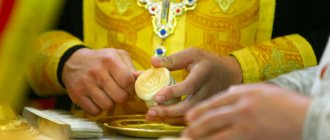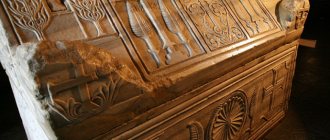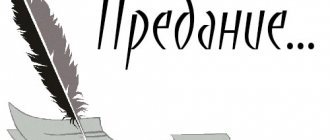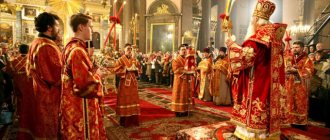The part of the church service that precedes the Divine Liturgy is called proskomedia.
What is proskomedia, what is the priest’s answer? This is a very important action in Orthodoxy: during it, wine and bread are prepared, symbolizing the Blood and Body of Christ , for the climax of the Liturgy - the Sacrament of Communion. At the same time, pieces are taken out from the prosphora with a list of names from the notes submitted by parishioners and prayer for them - both living and those who have left this world.
The name “proskomedia” translated from Greek means “preparation”, which in principle is the essence of the action. Another meaning is “bringing.” It has been preserved since ancient times, when the first Christians baked the prosphora necessary for the Liturgy themselves and brought it with them along with wine, and after the proskomedia they took the bread home.
The meaning of proskomedia
Translated from Greek, this term means “bringing” or “preparation,” which fully conveys the essence of the ritual. In the first centuries after the rise of Christianity, people baked prosphora themselves, which they brought to worship along with wine, and took back home at the end of the ceremony.
The sacrament of the Eucharist is a church ritual that helps to cleanse the soul and become closer to the Lord
Today, proskomedia is an action preceding the Divine Liturgy, consisting of the preparation of the Holy Gifts for the Sacrament of the Eucharist. During the ceremony, all the living and deceased are remembered, whose names were submitted to the priest with a special note.
Often parishioners confuse this ritual with mass, but the difference is simple. During the proskomedia, the priest takes out small pieces from the prosphora according to the number of people being commemorated. But during mass, he reads out notes to the choral singing of “What is Worthy.”
The ritual preceding the Divine Liturgy symbolizes the washing with the Blood of the Savior, and also represents the unity of the church. Pieces of bread drowning in wine represent the resurrection and subsequent eternal life. Metaphorically, this means the sacrifice of Christ, with which he atoned for all human sins. Thus, thanks to proskomedia, the soul is cleansed from passions, but only from those for which the layman has repented before the Lord.
What is the difference between proskomedia and mass?
The main difference between proskomedia and mass is the ritual and time of remembrance. During the service, the priest reads a prayer and takes out several pieces from the prosphora. And during the ceremony of mass, the church minister reads the notes, and the church choir at this time sings “It is Worthy to Eat.” Both rites are carried out publicly or secretly.
The most ideal is considered to be commemoration during the entire service intended for this. The special power of remembering one’s neighbor does not differ from each other.
We have discussed what proskomedia is in Orthodoxy. But before it takes place, the deacon and priest prepare very carefully, which makes it possible to carry out the ceremony in accordance with all Orthodox rules. There are several most important and simply necessary nuances that must be observed:
- Before going to the altar, a prayer must be read. It is repeated immediately before the altar;
- To perform a sacred ceremony, the clergyman must wear clothes specially designed specifically for this rite;
- The church minister performs the hand washing procedure, during which he reads verses from the 25th Psalm.
The best article for you, go to: What does canon mean and how does it differ from akathist
The service itself takes a short amount of time. The deacon and the priest stand directly opposite the altar, on which are placed sacred vessels filled with an asterisk, a shroud, a chalice, a spear and a paten. Rituals using sacred bread are carried out while reading prayer verses.
After reading the prayer, the church ministers prepare for the liturgy, which is the solemn part of the service. It must also follow certain rules:
- glorification of the holy meal by all parishioners and the deacon;
- reading several prayers specifically intended for this rite;
- the deacon's request from the clergyman to proceed to the next part of the liturgy.
It is difficult to unequivocally answer the question of which is better: a proskomedia for health or a prayer service. Each church ceremony is individual and useful in its own way. In order to decide what kind of prayer you need in the current situation, it is recommended to seek help from the clergy.
The Lord is always with you!
Time of the proskomedia
The rite is usually performed from 9 a.m. to 12 noon. But when the Divine Liturgy turns into Vespers, it is held in the afternoon, but only before dusk. According to the church charter, all days of the week are suitable for proskomedia, except:
- Wednesdays and Fridays of Cheese Week;
- Monday, Tuesday, and Thursday throughout Easter Lent;
- Good Friday (unless it falls on Annunciation);
- Fridays before Christmas and Epiphany.
Also, the ritual is prohibited from being performed on the days of the Liturgy of the Presanctified Gifts:
- Monday, Tuesday, Wednesday of Holy Week;
- Monday, Tuesday, Thursday from the second week of Easter Lent;
- Wednesday, Friday of the first six weeks of Lent;
- Tuesday, Thursday of the fifth week of Easter Lent.
The rite is usually performed from 9 a.m. to 12 noon.
What kind of bread and wine are used when performing proskomedia?
Not all bread and wine are suitable for proskomedia. Bread, also called prosphora, must be leavened, wheat, round, clean, fresh, two-part (that is, consisting of two parts: upper and lower); The wine for proskomedia requires red grape wine, since the red color resembles the color of blood (although white wine is also allowed in the Romanian Orthodox Church). In practice, Cahors is used for proskomedia, which, however, is not a statutory requirement.
Preparation for the proskomedia
To the ceremony preceding the Divine Liturgy, parishioners usually bring prosphora and other gifts with them. The clergy prepare bread for the Sacrament of the Eucharist, as well as wine. They put on a festive robe, in which they perform a ritual, asking the Lord for the people mentioned in the notes. To perform the ritual, the church requires special Eucharistic utensils related to two main Orthodox events: Christmas and the Crucifixion of the Savior. Such items are:
- a cup for consecrating wine;
- dish for separating prosphoras;
- an asterisk symbolizing the Star of Bethlehem;
- double-sided knife with a triangular blade;
- cloth panels that cover the paten and chalice separately;
- the material that joins the bowl and metal dish together;
- censer;
- anti-mine sponges;
- brass ladle;
- vessels for sacred bread, wine and water.
Who can be remembered at the proskomedia?
The notes contain the names of only those baptized in the Orthodox Church. In many churches, especially monasteries, notes for proskomedia may not be accepted if those for whom they are asked to pray are not faithful: they do not participate in church Sacraments, they are not churchgoers. The Venerable Leo of Optina said: “A spiritual person rightly told you about the commemoration at Proskomedia that sinners who are in error and schism should not be clearly remembered: according to the interpretation of church teachers, through the combination of particles taken out for their names with the Divine Blood, not cleansing, but the highest condemnation occurs for them. For a sinner who has repented and begun to reform, you can pray and submit to Proskomedia.”
The procedure for performing the ritual
The ritual is performed in the altar with the gates closed in Church Slavonic. The priest performs it in a low voice, since the ritual symbolizes the Birth of Christ, who came into our world very quietly. First, the priest reads a prayer over five prosphoras laid out on a platter. Next, he uses a knife to cut out a cube from the middle of the Big Bread, representing the Sacrificial Lamb, which he places on the paten. After this, he takes out smaller pieces from the remaining prosphoras:
- in the name of the Blessed Virgin Mary;
- John the Baptist;
- apostles;
- prophets;
- saints;
- all church members.
The priest places small pieces of prosphora around the Lamb in a certain order established by the church charter.
The next stage of proskomedia is reading notes about health and repose. With each name pronounced, the priest cuts out a piece from the smaller loaves, saying: “Remember, Lord (name).” After the end of the ritual, all the particles are placed in a chalice with wine, and the clergyman reads a prayer.
Completing the ritual, the priest brings out the star. With it he covers a piece of the Large Prosphora so that the cloth for covering the bowl and paten does not touch it. The shrouds symbolize the swaddling clothes that covered the newborn Jesus, as well as the shroud used after His martyrdom.
Next, the clergyman conducts censing on the walls of the temple and the parishioners present. It is no coincidence that incense is used, because it was the first gift of the Magi who came to visit the infant Christ.
Concluding the ritual, the priest prayerfully asks the Almighty to accept the prosphora dipped in wine as a sacred gift, and also to grant mercy to everyone mentioned in the notes. Then the entrance to the Altar is solemnly opened, metaphorically opening for all humanity the Gates of the Kingdom of Heaven, which bestows eternal life. Next, the service smoothly flows into the second part of the Divine Liturgy.
Cutting out prosphoras
Reading notes on health and repose
Each wall of the temple
When else are they remembered...
You can also submit notes for health and peace to other services. In some churches - each with its own rules - so-called simple and custom notes are practiced. In the first case, names are read only on the proskomedia. In the second, the same names are heard, in addition to this service, also during mass, as the Liturgy is also called, and prayer.
People of God are remembered on:
- Liturgy. Liturgy (mass), when names are read aloud;
- a special litany (special prayer), after reading the Gospel;
- prayer service;
- memorial service (only for the deceased);
- forty-year
It is impossible to say unequivocally which commemoration at which service is better or, so to speak, more effective: in any case, it is a prayer, and the power of church prayer, whenever they sound, is the same.
Many people are often interested and confused by the difference in the amount of donations for different services, in particular very small ones for proskomedia. The significance of the service does not suffer at all from this; as already mentioned, this is the highest degree of remembrance, and it should be accessible to everyone to the maximum extent.
A few words about the prayer service
This service is most often served after the Liturgy, sometimes at any time - as needed.
At the prayer service they pray only for the living. This is a special service where they pray only for the living. You can order it, so to speak, directly: to the Savior, the Mother of God, or one of the especially revered saints.
For example, for the health of a patient, as a rule, they pray to the Great Martyr and Saint Panteleimon; about travelers - St. Nicholas the Wonderworker, etc., which needs to be noted in the note.
Prayer services can be petitionary or thanksgiving. If everything is clear with the first ones, then the second ones are obligatory when your prayer is fulfilled.
If a prayer service has been ordered, then the note is read both during the proskomedia in the altar and at the prayer service - already aloud.
Proskomedia and Sorokoust
Sorokoust is a special prayer, and it is performed during 40 Divine Liturgies. If a person is alive, but perhaps ill, a magpie for health is ordered. However, you can pray in this way for any person if you wish him spiritual help.
If a person has died, such a service is held for the repose of his soul. When is the best time to order it?
- For the one who has just passed away, the so-called newly deceased;
- on Memorial Day;
- on your birthday;
- when you just want to remember.
Since this commemoration takes place at the Liturgy, then, naturally, every time a proskomedia is performed at the altar, i.e. the already described bloodless sacrifice is offered for the people included in the note.
The preparatory service before the Liturgy, called proskomedia, is, as already mentioned, its important part, showing the unity of all members of the Church, who are united by the Blood of Christ and faith in Him.
Its importance is very well stated in one book, which tells about the posthumous adventures of the heroine. Every day, when she came to the other world, the bird brought and threw bread, which greatly supported her and her companion.
When the soul was allowed to return to the body, having emerged from clinical death, it turned out that at every Liturgy the woman was remembered by her close friend, and the bread received was nothing more than a particle taken out of the prosphora at the proskomedia.
How to submit a health note to Proskomedia
Before the start of the ritual, parishioners, as a rule, submit special notes to the clergyman, which mention the names of those for whom they are asked to pray. Common prayer, strengthened by a single faith, helps to cope with illness, difficult financial situations, or end a streak of failures in life. However, for it to have an effect, the person being prayed for must also make some efforts:
- be baptized according to Orthodoxy;
- have sincere faith in God's help;
- lead a righteous lifestyle, regularly cleansing your body and soul with prayers.
Notes are usually written on small forms that are sold in the temple. However, the church charter allows the use of half a regular notebook sheet. The purpose of the commemoration must be indicated at the top: for health or for repose.
You can write no more than ten names on one form. They are entered in block letters or in clearly legible words in the genitive case. First, you can indicate the status of the person commemorated (prisoner, sick, wandering, baby).
Notes are usually written on small forms
It is important to submit a note in advance so that the priest understands how many pieces of prosphora will be on the paten.
Author's advice
Today, every church belonging to the Moscow Patriarchate is open to submitting applications for proskomedia. Absolutely any names can be entered on the form, except for those people who have not accepted the Orthodox faith or have not undergone the rite of Baptism.
Proskomedia is an integral part of the Sacrament of the Eucharist. The service is structured in such a way that the sacred rites smoothly flow into each other, and each of them has its own meaning. By performing a ritual over the Sacred Gifts, there is an appeal to the Lord so that He will forgive sins and allow His children to reunite with Him.
If you find an error, please select a piece of text and press Ctrl+Enter.
Conclusion
It is very important to submit notes to the proskomedia. After all, at the end of the service, the priest immerses all the particles for whom he prayed into a cup with the Blood of Christ with a request to wash away all sins. The Lord washes those commemorated at the proskomedia with His martyr’s blood. But you should not think that a piece of paper given to the priest frees you from your own prayer.
Sources:
- https://molitva-info.ru/duhovnaya-zhizn/proskomidiya-o-zdravii.html
- https://ikona-i-molitva.info/proskomidiya-o-zdravii-chto-eto/
- https://pravoslavie.guru/tserkovnye-obryady/otlichiya-proskomidii-ot-molitvy-za-zdravie-i-za-upokoj.html
- https://molitva.guru/tserkovnye-tainstva-i-obryady/chto-takoe-proskomidiya-kak-i-za-kogo-mozhno-podavat-zapisku.html
- https://verovat.com/tainstva/proskomidiya.html
- https://religiya.guru/obryady-i-prazdniki/kak-podat-zapisku-na-proskomidiyu-i-chto-eto-takoe.html
Sorokoust
Sometimes in church you can see people ordering the so-called “sorokoust”. Sorokoust is a special, enhanced prayer of the Church for the health or repose of its children. During the forty Divine Liturgies, the serving priest at Proskomedia commemorates the person (more precisely, his name) served on the magpie.
There is a practice when notes are commemorated at the evening service, and then again in the morning at the liturgy. The particles taken out in the evening are stored in a special closed container. At Proskomedia, the priest transfers all these particles to the paten, where the Lamb is located - the sacred bread, which is to become the Body of Christ.
| Patriarch, Metropolitan, archpriest, priest, deacon, monk - respectively. This is the meaning of clergy titles. | |
| IN. | Warrior |
| Cont. | Not idle. That means she's pregnant. |
| Jr. | Baby. For children under 7 years of age. |
| Neg. | Youth. Children aged 7 - 14 years. |
| B. Bol. | Sick |
| Ub. | Murdered |
| New | Newly deceased. Deceased no earlier than 40 days ago. |
What does proskomedia symbolize?
The proskomedia commemorates the Nativity, suffering and death of Jesus Christ. The Nativity of the Savior is marked by the preparation of the Holy Bread and the removal of the Lamb; nativity scene - altar; manger of the Infant God - paten; Star of Bethlehem - star; His shrouds are coverings; gifts of the Magi - chalice, censer and incense; the doxology of the Bethlehem shepherds and wise men - prayers performed by the priest performing the proskomedia. The paten is also a symbol of the Holy Sepulcher; shrouds - His burial shrouds; the cross-shaped cutting of the Lamb and the piercing of it with a spear serve as symbols of the Savior’s crucifixion and the outpouring of His blood. In addition, the time when the Lord was on the cross, and the warrior pierced His side with a spear and blood and water flowed out of the pierced Body, is reminiscent of wine combined with water poured into a chalice. Another symbol is the five prosphoras used at the proskomedia; it recalls the Gospel miracle of the Lord feeding five thousand people with five loaves. The two-part structure of the prosphora symbolizes the Divinity and Humanity of the Savior. The union of all particles around the Lamb on the paten signifies the Church, the Head of which is our Lord Jesus Christ.
***










